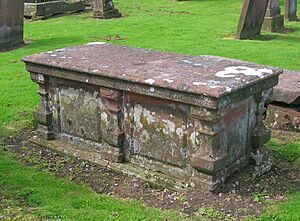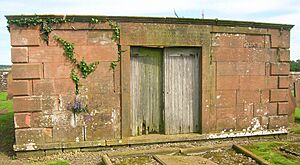Dunscore Old Kirk facts for kids
Quick facts for kids Dunscore Old Kirk |
|
|---|---|
| Dunscore Old Kirk and burial ground | |

General view of Dunscore Old Kirk burial ground
|
|
| OS grid reference | NX 92661 83241 |
| Location | Merkland, Dumfries and Galloway |
| Country | |
| Denomination | Protestant |
| History | |
| Former name(s) | Kirk of Dunscore |
| Status | Replaced by Dunscore Kirk |
| Founded | 13th century |
| Events | Significant links with Robert Burns |
| Architecture | |
| Functional status | Cemetery in use in 2000 |
| Heritage designation | Category B listed |
| Closed | 1645 |
| Specifications | |
| Materials | Dressed red sandstone and rubble |
| Administration | |
| Parish | Dunscore |
Dunscore Old Kirk was an old church located in Dumfries and Galloway, Scotland. It was also known as the Kirk of Dunscore. This church was built on a small hill near a road leading to Merkland.
It was about 3 kilometers from Auldgirth. The old church was close to Fardingwell Farm. It was also located between Isle Tower and Ellisland, where the famous poet Robert Burns lived.
Today, you cannot see any parts of the old church building. However, the churchyard, which is a special burial ground, is still used. People from nearby farms like Isle Tower and Friars Carse are buried there.
Contents
History of Dunscore Old Kirk
The first church building was started around the year 1170. A Norman lord gave the land for this church. The land was later given to the Abbey of Holywood.
Monks from the Cistercian order, who lived at Melrose Abbey, helped a lot in this area. They improved the land by making better drainage systems. They also taught people how to grow new crops and raise animals.
The church was first mentioned in official records in 1257. It was mentioned again in 1412 during a disagreement between monks.
Around the year 1600, a map by Timothy Pont clearly showed the church. It was marked as 'Kirk of Dunscore'.
By 1645, the church building was in very bad condition. It was also far away from most people in the parish. Because of this, people decided to build a new church. This new church was built in the place now known as Dunscore.
The Old Kirk Burial Ground
Maps from 1855 show that the burial ground was a rectangular area. It was in the fields off a small road north of Fardingwell Farm. A path led up to this area. It ended near a spot called the 'Laird of Lag's Tomb'.
Today, the burial ground is surrounded by a strong stone wall. In 1855, trees were shown all around the cemetery.
The biggest building in the burial ground is a mausoleum. This is a large tomb for the Ferguson family, who lived at the nearby Isle Tower. An inscription on the mausoleum says it was built in 1770. It remembers Robert Ferguson of Isle, who passed away in 1767.
Some of the larger burial plots still have cast iron railings around them. These railings were often removed during World War II to use the metal. However, they were kept in this quiet, remote place.
Robert Burns' Connections

The Dunscore Old Kirk burial ground has a special link to the famous Scottish poet Robert Burns. This is because the tomb of Robert Riddell of Glenriddell is located there. Glenriddell is now known as Friars Carse.
Robert Burns and his family lived at nearby Ellisland Farm from 1788 to 1791. For some years, Burns was good friends with Robert Riddell. Burns even used a quiet place called the 'Hermitage' at Glenriddell House.
Their friendship had a difficult period later on. Sadly, Robert Riddell passed away before they could become friends again.
'Cruel Lag' and the Covenanters
The Dunscore Old Kirk burial ground is also connected to the Covenanters. These were people in Scotland who strongly believed in their religious beliefs. They signed agreements, or "covenants," to protect their faith.
The burial ground has a memorial for Sir Robert Grierson. He was known as 'Cruel Lag' because he treated Covenanters in the area very harshly. His tomb is located against the back wall of the Ferguson family mausoleum.
The gravestone has the Grierson family's coat of arms. It says that Sir Robert Grierson passed away in 1733. The oldest Grierson memorial in the burial ground dates back to 1656.
The remains of Lag Tower, a 16th-century building, are located elsewhere. This tower used to belong to the Grierson family.
The New Kirk in Dunscore
In 1649, two men, James Grierson and James Kirko, asked the Scottish Parliament for permission. They wanted to move the church to its current location in Dunscore.
At that time, the old Kirk was in such bad shape that people were afraid to go inside. They felt it was too dangerous to worship there.
James Grierson gave the land for the new church. It was built on the spot where it still stands today. The church has been rebuilt there a second time since then. The village of Dunscore was called Cottack back then.
A copper baptismal font was moved from the old Kirk. It was hidden inside one of the new church's walls. The Reverend Robt. Archibald was the first minister in the new Kirk.
In 1923, the baptismal font was taken out of the wall. It was then placed on its current stand. Another item from the past is a carved red sandstone block. It has the date 1649 and a Bible verse: "How amiable are thy tabernacles, O Lord of Hosts to me"..
See also



